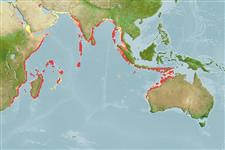>
Ovalentaria/misc (Various families in series Ovalentaria) >
Ambassidae (Asiatic glassfishes)
Etymology: Ambassis: Derived from Greek, anabasis = climbing up (Ref. 45335).
More on author: Lacepède.
Environment: milieu / climate zone / depth range / distribution range
Écologie
marin; eau douce; saumâtre démersal; océanodrome (Ref. 51243). Subtropical
Africa: Subtropical eastern South Africa to Kenya, Madagascar, Réunion and Mauritius (Ref. 50956).
Length at first maturity / Taille / Poids / Âge
Maturity: Lm 5.0 range ? - ? cm
Max length : 15.0 cm SL mâle / non sexé; (Ref. 52193)
Description synthétique
Clés d'identification | Morphologie | Morphométrie
Épines dorsales (Total) : 8; Rayons mous dorsaux (Total) : 9 - 10; Épines anales: 3; Rayons mous anaux: 9 - 11. Diagnosis: Ambassis ambassis has the following combination of characters: a single supraorbital spine; rostral spine absent; preopercle ridge and rear margin serrate; interopercle edge smooth except for few small serrae at angle; 2-3 rows of cheek scales; predorsal scales 13-18; lateral line continuous (normally); lower gill rakers 19-23; pectoral-fin rays 14-15 (Ref. 50956).
Tolerant of freshwater when water temperature is within 7-32°C (Ref. 7248, 79840). Tends to be more tolerant of lower temperatures in water of low salinity (2ppt) than in seawater (Ref. 7248). Feeds at night on crustaceans, fish fry and larvae and insects (Ref. 7248). Salt dried and eaten in some countries (Ref. 12484)
Life cycle and mating behavior
Maturities | Reproduction | Spawnings | Egg(s) | Fecundities | Larves
Fricke, R., 1999. Fishes of the Mascarene Islands (Réunion, Mauritius, Rodriguez): an annotated checklist, with descriptions of new species. Koeltz Scientific Books, Koenigstein, Theses Zoologicae, Vol. 31:759 p. (Ref. 33390)
Statut dans la liste rouge de l'IUCN (Ref. 130435)
Menace pour l'homme
Harmless
Utilisations par l'homme
Outils
Articles particuliers
Télécharger en XML
Sources Internet
Estimates based on models
Preferred temperature (Ref.
123201): 23.9 - 28.8, mean 27.3 °C (based on 254 cells).
Phylogenetic diversity index (Ref.
82804): PD
50 = 0.5000 [Uniqueness, from 0.5 = low to 2.0 = high].
Bayesian length-weight: a=0.01445 (0.00826 - 0.02530), b=2.99 (2.84 - 3.14), in cm total length, based on LWR estimates for this species & (Sub)family-body (Ref.
93245).
Niveau trophique (Ref.
69278): 3.7 ±0.56 se; based on food items.
Résilience (Ref.
120179): Haut, temps minimum de doublement de population inférieur à 15 mois (Preliminary K or Fecundity.).
Fishing Vulnerability (Ref.
59153): Low vulnerability (10 of 100).
